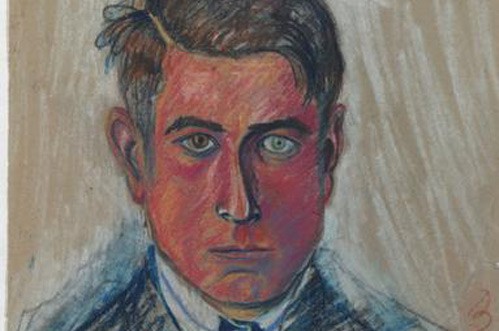
Anton Mahringer was born on 26 September, 1902 in Neuhausen near Stuttgart (Kingdom of Wuerttemberg, Germany) as the son of the local primary school teacher and the post-office clerk.The family moved to Schwaebisch Gmuend, where the father taught young people training to be goldsmiths. The son was there given the opportunity to explore his artistic talent in painting classes, while his father rose to the position of deputy lord mayor. In 1921, after his school-leaving certificate, he got a job at the Stuttgart customs office. His knee was badly injured, after which it remained stiff for the rest of his life, and he took on a banking apprenticeship. He continued taking painting classes at the goldsmiths' college and got in touch with local artists. After he had finished his apprenticeship, he enrolled at the Stuttgart school of applied arts. Additionally, he attended night classes in nude drawing at the Stuttgart academy. In 1924, he was admitted to the academy, where he attended Arnold Wahrschmidt's drawing class. Mahringer's father, a widower, remarried. It was at his stepmother's orchard in Schwaebisch Gmuend, that Mahringer set up his first studio. There, he accomplished landscapes and figurative sketches. A field trip during the summer acquainted Mahringer with the Tyrolean Alps.
In 1926, Mahringer visited the international art show in Dresden. He was especially impress by Max Slevogt's Egyptian landscapes and the German Expressionists. In 1927, he won the academy's awards for the best nude drawing and the best overall performance of the year. The prize money helped to finance a trip to Italy. A field trip organized by the academy took him to Vienna for the first time. In 1928, Mahringer changed to Anton Kolig's painting class. Mahringer became Kolig's assistant and one of the leading staffers in Kolig's murals workshop. A great commission took Mahringer to Klagenfurt, where he had his first exhibition.
In 1931, Mahringer received a Wuertemberg state scholarship for a stay in Rome during the summer. There, he met Teilhard de Chardin-Forscher, François-Albert Viallet, Werner Gilles, and Karl Kluth. After his Roman sojourn, Mahringer moved in with Hans Gassebner in Labientschach in the Gail Valley. His brother Paul, an artist as well, was living in the neighbouring village of Saak at the time.
In 1932, Anton Mahringer married Kolig's pupil Regina Peschges and sold his first artwork. Together with Gassebner, the Mahringers travelled to Dalmatia in 1934 and visited the Venice Biennale. At the Villach town hall, the artistic fruits of the trip were exhibited, the Albertina acquired a watercolour. Group shows at the Carinthian Kunstverein (art association), the Künstlerhaus (artists' house) of Klagenfurt, and the Viennese Secession followed.
During the war, Mahringer worked as a drawing teacher at the "Hauptschule" in Hermagor, in 1939 he became a member of the Viennese Secession. In 1941, he participated in the Carinthian "Kunstschau" (art show) at the Residence gallery in Salzburg. After Franz Wiegele died in 1944, Mahringer took over his house and studio in the Kessel forest.
In the post-war years, Mahringer exhibited in Klagenfurt, Salzburg, Viennese gallery Wuerthle and the Graz Joanneum. In 1948, Mahringer received the Austrian "Staatspreis" (state award) for painting, for his work "Abendlandschaft" (evening landscape). Mahringer travelled around Ischia and the Carnic Alps: until 1959 he would paint at the Oisternig every summer. In 1953, the gallery Welz in Salzburg organised a great Mahringer exhibition; at the same time Bruno Grimschitz's monography on Mahringer saw the light of day. The exhibition was taken to Stuttgart, Saulgau, Wuppertal, Mannheim and Klagenfurt. At the graphic competition in Innsbruck, Mahringer won the "Preis des Landes Kärnten" (award of the State of Carinthia); in the framework of the cultural exchange scheme of the State of Carinthia, he exhibited in Ljubljana and Udine. It was through the medium of Welz, that he was commissioned to carry out five oil paintings for the Austrian embassy in Ottawa. With the payment, he built a house in St. Georgen. In 1956, he was granted the title "Professor". In 1957, he got a one-man show at the Viennese Künstlerhaus and received the "Große Goldene Ehrenmedaille" (great gold medal) des Künstlerhauses.
One-man show and group shows in Ljubljana, Ulm, Frankfurt/Main, Passau, Stuttgart and Klagenfurt. The Artist travelled to Yogoslavia, Swabia, Switzerland and other places. The early sixties saw further Mahringer shows in Cracow, Pittsburgh and Helsinki. In 1964, Mahringer was commissioned to carry out a large-scale wall mosaic for the Österreichische Draukraftwerke in Klagenfurt, and he worked on a mural for the town hall of his native town of Neuhausen. In 1965, Mahringer was in Istanbul for two months, to visit his daughter Monika, who had a teaching job there. The pictures he had done during that voyage were shown at the Carinthian "Staatsgalerie" (state gallery).
During the final years of his life, Mahringer exhibited in Schwaebisch Gmuend, Ludwigsburg, San Francisco, Linz, Braunau-upon-Inn, Graz and Vienna and other places; the art academies of Istanbul and Ankara, respectively, organised personal shows for him. The Austrian Cultural Forum New York showed Mahringers artwork in 1970. Mahringer's 70th birthday inspired the Carithian "Landesgalerie" to organise a great personal show for him. At the same time, a voluminous monography with a catalogue raisonné by Walter Zettl and Leopoldine Springschitz was published.
Anton Mahringer died in Villach hospital December 29, 1974.


